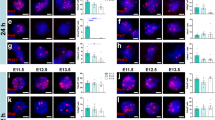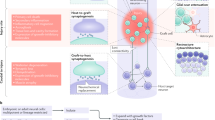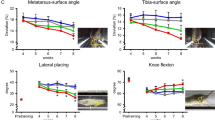Abstract
Transplantation approaches using cellular bridges1,2, fetal central nervous system cells3,4,5, fibroblasts expressing neurotrophin-3 (ref. 6), hybridoma cells expressing inhibitory protein-blocking antibodies7, or olfactory nerves ensheathing glial cells8 transplanted into the acutely injured spinal cord have produced axonal regrowth or functional benefits. Transplants of rat or cat fetal spinal cord tissue into the chronically injured cord survive and integrate with the host cord, and may be associated with some functional improvements9. In addition, rats transplanted with fetal spinal cord cells have shown improvements in some gait parameters10, and the delayed transplantation of fetal raphe cells can enhance reflexes11. We transplanted neural differentiated mouse embryonic stem cells into a rat spinal cord 9 days after traumatic injury. Histological analysis 2–5 weeks later showed that transplant-derived cells survived and differentiated into astrocytes, oligodendrocytes and neurons, and migrated as far as 8 mm away from the lesion edge. Furthermore, gait analysis demonstrated that transplanted rats showed hindlimb weight support and partial hindlimb coordination not found in 'sham-operated' controls or control rats transplanted with adult mouse neocortical cells.
This is a preview of subscription content, access via your institution
Access options
Subscribe to this journal
Receive 12 print issues and online access
$209.00 per year
only $17.42 per issue
Buy this article
- Purchase on Springer Link
- Instant access to full article PDF
Prices may be subject to local taxes which are calculated during checkout



Similar content being viewed by others
References
Richardson, P.M., McGuinness, U.M. & Aguayo, A.J. Axons from CNS neurones regenerate into PNS grafts. Nature 284, 264–265 (1980).
Xu, X.M., Guenard, V., Kleitman, N. & Bunge, M.B. Axonal regeneration into Schwann cell-seeded guidance channels grafted into transected adult rat spinal cord. J. Comp. Neurol. 351, 145–160 (1995).
Bernstein, J.J. & Goldberg, W.J. Fetal spinal cord homografts ameliorate the severity of lesion-induced hindlimb behavioral deficits. Exp. Neurol. 98, 633–644 (1987).
Bregman, B.S. et al. Recovery of function after spinal cord injury: mechanisms underlying transplant- mediated recovery of function differ after spinal cord injury in newborn and adult rats. Exp. Neurol. 123, 3–16 (1993).
Howland, D.R., Bregman, B.S., Tessler, A. & Goldberger M.E. Transplants enhance locomotion in neonatal kittens whose spinal cords are transected: a behavioral and anatomical study. Exp. Neurol. 135, 123–145 (1995).
Grill, R., Murai, K., Blesch, A., Gage, F.H. & Tuszynski, M.H. Cellular delivery of neurotrophin-3 promotes corticospinal axonal growth and partial functional recovery after spinal cord injury. J. Neurosci. 17: 5560–5572 (1997).
Schnell, L. & Schwab, M.E. Axonal regeneration in the rat spinal cord produced by an antibody against myelin-associated neurite outgrowth inhibitors. Nature 343, 269–272 (1990).
Li, Y., Field, P.M. & Raisman, G. Repair of adult rat corticospinal tract by transplants of olfactory ensheathing cells. Science 227, 2000–2002 (1997).
Anderson, D.K. et al. Transplants of fetal CNS grafts in chronic compression lesions of the adult cat spinal cord. Resor. Neurol. Neurosci. 2, 309–325 (1991).
Stokes, B.T. & Reier, P.J. Fetal grafts alter chronic behavioral outcome after contusion damage to the adult rat spinal cord. Exp. Neurol. 116, 1–12 (1992).
Privat, A., Mansour, H., Rajaofetra, N. & Geffard, M. Intraspinal transplants of serotonergic neurons in the adult rat. Brain Res. Bull. 22, 123–129 (1989).
Gage, F.H. et al. Survival and differentiation of adult neuronal progenitor cells transplanted to the adult brain. Proc. Natl. Acad. Sci. USA 92, 11879–11883 (1995).
Dinsmore, J. et al. Embryonic stem cells differentiated in vitro as a novel source of cells for transplantation. Cell Transplant. 5, 131–143 (1996).
Brustle, O. et al. In vitro-generated neural precursors participate in mammalian brain development. Proc. Natl. Acad. Sci. USA 94, 14809–14814 (1997).
Basso, D.M., Beattie, M.S. & Bresnahan, J.C. A sensitive and reliable locomotor rating scale for open field testing in rats. J. Neurotrauma 12,1–21 (1995).
Liu, X.Z. et al. Neuronal and glial apoptosis after traumatic spinal cord injury. J. Neurosci. 17, 5395–5406 (1997).
Bain, G., Kitchens, D., Yao, M. & Gottlieb, D.I. Embryonic stem cells express neuronal properties in vitro. Dev. Biol. 168, 342–357 (1995).
Lagenaur, C. & Schachner, M. Monoclonal antibody (M2) to glial and neuronal cell surfaces. J. Supramol. Struct. Cell Biochem. 15, 335–346 (1981).
Baumrind, N.L., Parkinson, D., Wayne, D.B., Heuser, J.E. & Pearlman, A.L. EMA: a developmentally regulated cell-surface glycoprotein of CNS neurons that is concentrated at the leading edge of growth cones. Dev. Dyn. 194, 311–325 (1992).
Waxman, S.G. Demyelination in spinal cord injury and multiple sclerosis: What can we do to enhance functional recovery? J. Neurotrauma 9, s105–s117 (1992).
Acknowledgements
This work was supported by National Institutes of Health grants NS01931, NS37927 (J.W.M.), NS32636 (D.W.C.) and RR-12309 (D.I.G.); the Alan A. and Edith L. Wolff Charitable Trust (D.I.G.); the Christopher Reeve Paralysis Foundation (J.W.M. and D.W.C.); and the Keck Foundation (J.W.M., D.W.C. and D.I.G.).
Author information
Authors and Affiliations
Corresponding author
Rights and permissions
About this article
Cite this article
McDonald, J., Liu, XZ., Qu, Y. et al. Transplanted embryonic stem cells survive, differentiate and promote recovery in injured rat spinal cord. Nat Med 5, 1410–1412 (1999). https://doi.org/10.1038/70986
Received:
Accepted:
Issue Date:
DOI: https://doi.org/10.1038/70986
This article is cited by
-
Laser-activated autologous adipose tissue-derived stromal vascular fraction restores spinal cord architecture and function in multiple sclerosis cat model
Stem Cell Research & Therapy (2023)
-
Electrical stimulation affects the differentiation of transplanted regionally specific human spinal neural progenitor cells (sNPCs) after chronic spinal cord injury
Stem Cell Research & Therapy (2023)
-
Progression in translational research on spinal cord injury based on microenvironment imbalance
Bone Research (2022)
-
The role of neural stem cells in regulating glial scar formation and repair
Cell and Tissue Research (2022)
-
Transplantation of PSA-NCAM-Positive Neural Precursors from Human Embryonic Stem Cells Promotes Functional Recovery in an Animal Model of Spinal Cord Injury
Tissue Engineering and Regenerative Medicine (2022)



